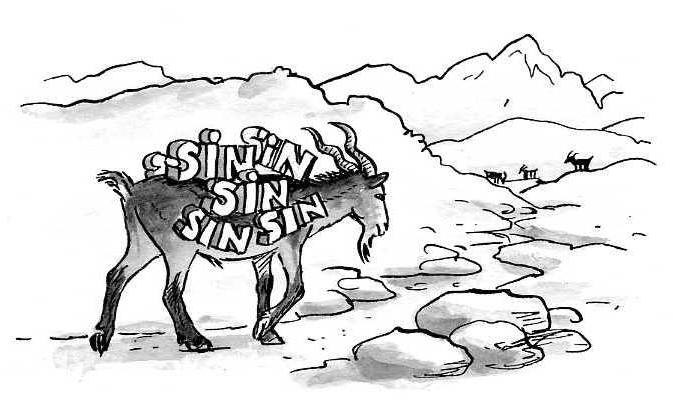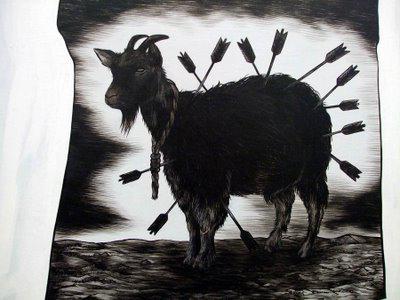In our time, the words "scapegoat" have become phraseological units. This idiom has long lost its original meaning. What did she mean originally? Why a goat, and not some other animal? And whom or what did he let go? What metamorphoses and rethinking has the idiom undergone in the future? Learn about this from this article. We will tell you in which cases it is appropriate to use this expression. Let us also consider which phraseological unit is closest in meaning to the “scapegoat” and why this synonym is used.
Purification ritual
The historical roots of the origin of the phrase “scapegoat” should be sought in Judaism. The Old Testament book of Leviticus in chapter 16 on behalf of God gives clear instructions on what the high priest and the rest of the people of Israel must do in order to be cleansed from sins and receive forgiveness from the Lord. On the holiday of Yom Kippur, which is celebrated "in the seventh month, on the tenth day" according to the Jewish calendar, four animals were brought to the temple. These were a young goby (taurus), a ram (aries) and two goats of the same suit. The priest has metal lots with respect to these last two animals. On which of them the choice fell, was set aside. Three others were slaughtered, the tabernacle was consecrated with their blood, and carcasses were burned in front of the temple as a sacrifice to God. The surviving goat was brought to the high priest. He laid both hands on his head and confessed all the sins of the Jewish people. It was believed that as a result of such a ceremony, all the fault of people before God passed to the animal. After that, a special messenger took the goat to the waterless Judean desert, where he left him to die a brutal starvation. According to another version, the animal was thrown into the abyss from the Azazel rock, which was considered the abode of the Devil.

A gift to Satan?
This ritual, which was practiced even at the time of the first tabernacle (X century BC) and right up to the destruction of the Jerusalem temple (1st century BC), gave rise to a mistaken belief among neighboring peoples that the Jews were sacrificing to the Devil. Like the rite of slaughter and burning outside the city of a bright red cow, sending small cattle to the desert did not mean a gift to anyone. Then who, or rather, what was the scapegoat? The meaning of this ritual is this: all the evil deeds of the people were assigned to the animal. Thus, it turned into a receptacle of sins. The goat was sent to the desert, where demons lived, and the people of God cleansed of contamination could communicate with the Lord. In the early rites, absolution was accompanied by the fact that a piece of red cloth was tied to the horns of the animal. Before leaving the mill, the tape was cut in half. Half the rags were tied to the gate, while the rest remained on the animal. If the repentance of the Jews before God was sincere, then at the time of the death of the goat in the desert, the rag should have turned white. A red cow was considered a symbol of the golden calf, lust, the beginning of all sins.

Rethinking the scapegoat ritual in Islam and Christianity
In the world religions that honor the Old Testament, an inevitable interpretation of this rite has occurred. In Islam, there is a special ritual of stoning Satan. True, no animal is no longer “loaded with sins”. People just go to the valley, where, according to beliefs, the Devil dwells, and throw stones there. In Christian theology, the scapegoat is sometimes interpreted as a symbolic image of the sacrifice of Jesus Christ. All the Gospels and other books of the New Testament are full of references to the fact that the Son of God took on his shoulders the original sin of mankind, which came from the disobedience of Adam and Eve, and atoned for it with his death. True, our Lord Jesus is not called a "goat", but "the Lamb of God" (for example, the Forerunner in the Gospel of John 1:29 calls him that). But from the ritual of the scapegoat, the atoning sacrifice of Jesus Christ is distinguished by one very important detail. This is voluntary. The animal did not choose its death itself, it was appointed to be a scapegoat.

Vitality of the image
Jews were not the only people who practiced such a rite of transmission of sins and the subsequent killing of the "container of evil." J. Fraser, a researcher of ancient beliefs, notes that everywhere, from Iceland to Australia, people sought to get rid of the evil, adverse forces of nature in a similar way. In ancient Greece, in the event of natural disasters or pestilence, criminals or prisoners were always ready to be sacrificed. Beliefs that sins can be the cause of universal calamities are also observed among the Slavic peoples. So, the rite of burning a scarecrow of Winter has ancient rituals of human sacrifice under it. A peculiar “scapegoat” was practiced by agricultural peoples on the feast of the first furrow, haymaking, and the last sheaf.
Turning into a metaphor
People tend to shift blame from themselves to others. It is very convenient and drowns reproaches of conscience. Many of us have experienced in our own skin what “scapegoat" means. But even more often we blame others for our bad deeds. “I didn’t do the work because they interfered with me,” “I lost my temper because they brought me” - we hear such excuses every day and pronounce them ourselves. Perhaps the share of guilt of these "others" is present. But are we becoming less guilty of this? Due to the fact that the practice of “shifting from a sick head to a healthy one” is ubiquitous and at all times, a single ritual of the Jewish people has become a household name.
"Scapegoat": the meaning of phraseology
Now this idiom is used exclusively as a figurative expression, a metaphor. By “scapegoat” is meant a person who was unfairly blamed for the mistakes of other people, made guilty of failure to whitewash the real criminals. As a rule, such a “ritual animal” is the lowest employee in the hierarchy. Under the conditions of a corrupt system of investigation and trial, prisons are filled with scapegoats that have been sentenced for the actions of wealthy people who have been “punished” for taking bribes.
Propaganda tool
History knows many examples when politicians hid the reasons for their failures, accusing various pests and saboteurs, and sometimes entire nations, of disasters and misfortunes that befell people. Even during the time of the Great Plague (mid-14th century), Jews were blamed for the epidemic. This caused anti-Semitic pogroms that swept across Europe. Jews throughout history have often been recorded in the scapegoat category. The expression of why there is no water in the tap also exists in Russian. In Nazi Germany, the blame for the economic crisis was also placed on the Communists, Roma and other categories of the population. In modern Russia, such scapegoats are traditionally the West and the USA. So politicians always choose the extreme.
Goats and switchmen
Since the guilty people were often made guilty of the poor, unable to fend for themselves, the expression “scapegoat” appeared to have the synonym “switchman”. Why did this railway worker become a household person? Because at the dawn of the era of trains, crashes often occurred. In judicial investigations into the causes of the disaster, responsibility for what happened was often lowered down the hierarchical ladder until they settled on simple switchmen. Say, the whole structure went downhill due to his negligence. Therefore, the expression “turn arrows” is also common, meaning “to lay the blame on someone who has nothing to do with the case.” No less popular is the saying "bring the blame on the healthy." It means that the guilty person wants to shift the responsibility onto the shoulders of another person.